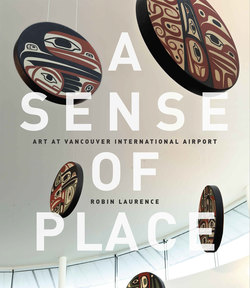Читать книгу A Sense of Place - Robin Laurence - Страница 18
На сайте Литреса книга снята с продажи.
Оглавление3
sculpture, Reid explored the levels of meaning conveyed by the canoe and those aboard it.)3The journeying theme, imposing scale and lively passengers of The Jade Canoe are beautifully suited to a busy international airport. And, in fact, the airport is beautifully suited to them.
Over the past two decades, the Airport Authority has designed new and expanding passenger terminals around the large-scale artworks it has commissioned, rather than dropping the pieces into previously built spaces. This innovative strategy has led to a wondrous unity of art and architecture rarely seen at airports before. Of special note is the Musqueam Welcome Area at the entrance to the Canada Customs Hall in the International Terminal, created to convey the presence as well as the greetings of the Musqueam people. It is of the highest significance that iconic sculptures by Susan Point and beautiful weavings by Krista Point, Robyn Sparrow, Debra Sparrow, Gina Grant and Helen Callbreath are among the first artworks encountered by international travellers arriving at YVR. While expressing the cultural traditions of the Coast Salish peoples, the sculptures and weavings also speak to YVR’s Sea Island site, in the estuarial mouth of the Fraser River, traditional Musqueam territory. The water cascading through the Musqueam Welcome Area signifies the salmon-bearing
and techniques were being explored. As a high-profile artist of mixed Haida and German-American descent, Reid was an important bridge between cultures when non-Native people began to take notice of the indigenous art of the Northwest Coast in the middle of the twentieth century.
The form and content of Reid’s sculpture were inspired by nineteenth-century miniature canoes carved in argillite, a black sedimentary stone mined on Slatechuck Mountain, on the densely forested archi-pelago known as Haida Gwaii, “the Islands of the People.” Created by Haida artists for trade with visitors to the Northwest Coast, argillite works (including platters, bowls, boxes, pipes and miniature poles) often drew their subjects from long-held aboriginal themes and stories. In the early years of Reid’s career, when he was educating himself in classical Haida style and techniques, he had closely studied such objects in museum collections.
The work was also informed by the artist’slate-life experience collaborating in the carving and launching of a suite of full-size cedar canoes. The metaphor of a vessel, crowded with crest figures and myth-time creatures and travelling to an unseen destination, resonated deeply with Reid — and continues to resonate with those passing through YVR. (In a poem titled “The Spirit of Haida Gwaii,” written to accompany the
The Spirit of Haida Gwaii: The Jade CanoeBill ReidSEE PAGE 34
